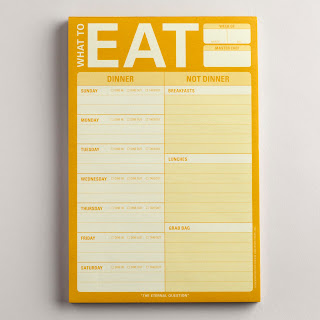Mental Wellness: whatever works - zero preparation foods, part 1
Let us digest the stages involved in eating at home:
- Planning the food shop
- Going to the shops
- Doing the food shop in a highly stimulating environment (noise, people, brand packaging)
- Going home
- Unpacking the food shop
- Deciding on what you want to eat at a given time
- Planning how to prepare the meal
- Getting the food from the fridge/cupboards
- Preparing your meal
- Eating your meal
- Washing the dishes
- Drying the dishes
- Putting the dishes away
- Collapse in a heap
Now, not everyone necessarily does all these stages all of the time, but, can we just agree that it is never as simple as imagining a meal and it magically appearing in front of you!
Let us chew over some of the things which can be affected by mental illness:
- Appetite (increased/decreased), sometimes manifesting in, or due to, eating disorders
- Energy levels needed to carry out the tasks
- Fatigue - some people may not feel able to leave bed for sustained periods of time
- Motivation to carry out any tasks including to move
- Attention needed to think about tasks
- Memory required to think about things such as shopping items and cooking times
- Planning and executive function skills needed to work out things like what meals you want that week, when and how to do the shop, managing money/remembering pin codes, cooking the meal...the list is endless here
- Anxiety levels e.g. it is common for people to feel anxious leaving the house and being around lots of people
- Excessive fears or worries
- Apathy e.g.a person may feel like they don't care about eating anymore
- Feelings of worthlessness e.g. a person may not feel they deserve to look after themselves
- Other worries caused by mental illness e.g. family/work/health appointments
Hopefully you can see by looking at the two lists just how COMPLETELY understandable it is that a person with mental illness can have so much difficulty with eating anything, let alone maintaining weight or getting any form of balanced diet.
The thing is, though, eating is extremely important for our physical health as well as our mental health (you can see some of the things that can be affected above are appetite, energy levels, fatigue, feelings of worthlessness): not eating can worsen these symptoms and so we can face a vicious cycle where
our mental health is stopping us eating, and our inability to fuel ourselves with nutrients is worsening our mental health.
We need to break the cycle
This blogpost comes in two parts and aims to reduce the stages involved in eating and drinking (above) in as many ways as possible so that for the time being you will be able to eat more easily, more often and hopefully add some variety into your diet as well.
This is not a post about how important it is to eat your '5 a day'.
It is about me knowing you are doing your absolute best but that you are still struggling. It is about me wanting to help you.
Lovely reader, lets try and make it a bit easier for you to eat something, anything, more often to give you a bit more energy to do other things and to give you a few less things to worry about.
This is not a post that dictates 'you must'.
It is about doing what you can; whatever works, for now, in order to keep going.
This is not a post about how important it is to eat your '5 a day'.
It is about me knowing you are doing your absolute best but that you are still struggling. It is about me wanting to help you.
Lovely reader, lets try and make it a bit easier for you to eat something, anything, more often to give you a bit more energy to do other things and to give you a few less things to worry about.
This is not a post that dictates 'you must'.
It is about doing what you can; whatever works, for now, in order to keep going.
1) Planning the food shop
1) Planning the food shop
Here is a list of ZERO preparation foods (I'm talking no peeling, no chopping, no heating, no stirring, no slicing, no shaking, no making: nothing) which you are welcome to use as a go-to shopping list.
You can add or delete foods to suit you.
You can add or delete foods to suit you.
Shopping list ideas for foods which require NO preparation
- Fresh Fruit e.g. apple, grapes, strawberries, blueberries, blackberries, cherry tomatoes, pots of prepared fruit e.g. melon, pineapple, mango
- Dried fruit e.g. mango, apricot, raisins, dates, banana
- Vegetables, pre-cut into small strips e.g. carrot, celery
- Pre-made salads e.g. salad boxes, couscous, pasta salad
- Pre-prepared cold food e.g. sandwiches, wrap or sushi
- Pre-made salads e.g. salad boxes, couscous, pasta salad
- Pre-prepared cold food e.g. sandwiches, wrap or sushi
- Chilled dairy e.g. yogurts, mousses
- Mini cheeses e.g. Dairylee Dunkers, mini babybell, mini cheddar packets, mini buffalo mozzarella
- Drinks e.g. fruit juice, smoothies, milk (full fat for extra calories), milkshakes, water (bottled or tap), breakfast drinks (e.g. Weetabix), Complan pre-prepared smoothies and milkshakes for added nutrients and calories
- Drinks e.g. fruit juice, smoothies, milk (full fat for extra calories), milkshakes, water (bottled or tap), breakfast drinks (e.g. Weetabix), Complan pre-prepared smoothies and milkshakes for added nutrients and calories
- Dips e.g. hummus (huge selections out there now), guacamole, raita, salsa, pate, Philadelphia, cottage cheese, coleslaw, tapenade, taramasalata
- Cooked meat e.g. ham, antipasti, strips of cooked chicken, roast beef slices,
- Savoury pastry e.g. sausage rolls (big variety in m&s), cocktail sausages, scotch eggs, mini pork pies, quiche
- Indian food e.g. precooked pakoras, samosas, onion bhajis
- Preserved/pickled/fermented e.g. smoked salmon, mackerel, tuna/salmon (ring pull cans), olives, sun-dried tomatoes, pickled onions
- Chutneys e.g. caramelised red onion, tomato and chilli, fig
- Dry food e.g. crackers, mini bread sticks, mini cheddars, rice cakes (sweet/savoury)
- Bread e.g. Pita bread, wraps, sliced bread, torn off baguette
- Nuts e.g. cashews, pistachios, almonds, graze boxes combine fruit, nut and chocolate
- Breakfast bars e.g. Go Ahead fruit bars, Trek bars, Meradin Protein bars, cereal bars, Belvita soft bake bars and biscuits
- Crisps e.g. potato, tortilla, corn, vegetable, crackers
- Popcorn e.g. sweet, salt, caramel
- Biscuits e.g. chocolate, digestives, Jaffa cakes (controversial!!), assorted packs, cookies, rich tea
- Chocolate e.g. bars, truffles, selections (e.g. quality street/heroes/roses), nuts, caramel, orange, mint, M&Ms, Smarties, Maltesers, Reeces
- Sweets e.g. Haribo, laces, Percy Pigs, licorice, fizzy, Pick 'n' mix
- Sweets e.g. Haribo, laces, Percy Pigs, licorice, fizzy, Pick 'n' mix
- Cake and sweet pastries e.g. chocolate, strawberry, lemon drizzle, hazelnut, coffee, carrot (for one of your five a day 😏) chocolate eclairs, meringues, lemon meringue pie, apple pie
- Small (or big!) ice cream pots and ice lollies
- Small (or big!) ice cream pots and ice lollies
2) Making your way to the shops
3) Shopping in overstimulating environment
4) Making your way back from the shops
If you are struggling - lets be honest, that's the understatement of the century - really suffering with your mental illness - and stages 2 to 4 seem completely impossible right now and are likely to feel impossible for a few days, then there are other options; you can:
- Ask somebody else to do the shop for you, e,g, friends / family / colleagues / neighbours, consider joining a site like www.helpfulpeeps.com where people in your area will be more than willing to help you with this task
- Do an online shop (the great thing about an online shop is that you can store your list and use it again in future!)
- Ask somebody else to do an online shop!
5) Unpacking the shopping
Personally, I tend to find this a bit easier than the other stages, but I know not everyone will. The good news is that the only frozen food in the list above is ice-cream and lollies so you can pop those away and then reward yourself with a little break after. Aim to put away the refrigerated items next. There are lots of foods that don't need to be cooled or frozen so there is no rush to put them away. Whatever works, remember?!
A really great thing about the non-refrigerated items is that they can be placed pretty much anywhere in the house.
Now lets go throw the rulebook out of the window:
Now lets go throw the rulebook out of the window:
I have days or weeks where it's almost impossible to leave my bed; getting to the en-suite toilet is like climbing Kilimanjaro. So, having a variety of e.g. cereal bars / nuts / crackers/ popcorn at my bedside along with (always!) a jug of water and glass will hugely, hugely help me get in some nutritional content and energy. When sugar levels drop, our mood dips, and so eating actively helps reduce feelings associated with depression and low mood.
Seeing the food might also help motivate you to eat.
- Try and break down the task into three stages:
1) Put frozen foods away as soon as possible
(break)
2) Put refrigerated foods away
(break)
3) Put 'cupboard foods' and fruit away
Important: place some of the food around the house in places you might go (even if it's unlikely): next to your bed, the living room table, a settee arm, a windowsill, you could even pop one or two on the bath, I don't judge. WHATEVER WORKS! You might even find yourself enjoying the novelty of this last stage - If the above is too hard, ask somebody else, such as family or friend, to help you with stages you are likely to struggle with or to put the items away for you, again consider a site like www.helpfulpeeps.com where people in your area will be more than willing to help you with this task.
I'd love to hear your comments about this post and whether you think the information and tips could, has, will or won't help you, as well as any further opinions, or things to include in the next post.









Comments
Post a Comment